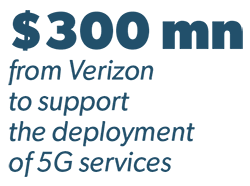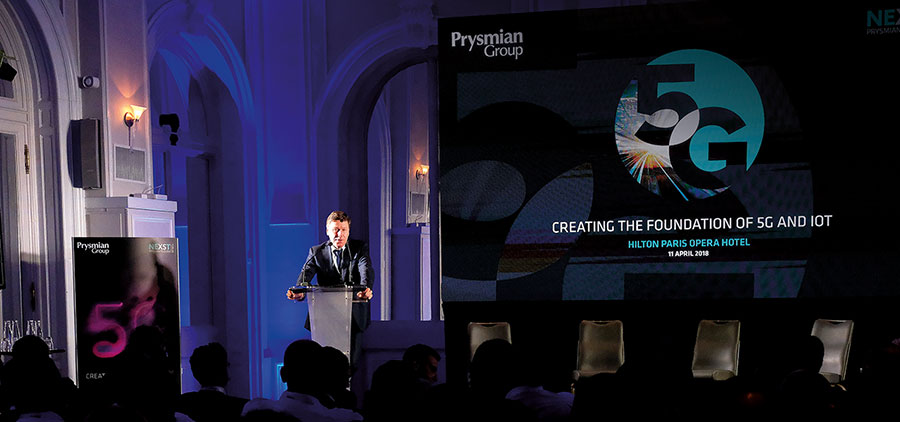The future is 5G.
And there is no 5G without Fibre
Global Scenario
The future is 5G. And there is no 5G without Fibre.
Fibre optic networks are key for upcoming 5G technology; there is no IoT, smart device proliferation, cloud computing or self-driving cars without 5G. And there is no 5G without fibre.
Prysmian Group is strongly committed to supporting governments and Telecom operators in developing new broadband networks by continuing to invest in optical fibre and cable capacity, as well as in new technologies and know-how. These strategic infrastructures must be based on high quality, while designed to provide high performance over time, so as to be ready for the services of the future like 5G, smart cities, smart transportation and smart homes.
NO 5G WITHOUT FIBRE

We are in the condition of having to build the foundation of something that is not yet clearly defined, and that will evolve with time. Philippe Vanhille, Senior Vice President Telecom Business at Prysmian Group
It has been estimated that by 2021, global Internet users will reach 4.6 billion, equal to 58% of the world’s population, while networked devices and connections will reach 27.1 billion, the equivalent of 3.5 devices per person. Philippe Vanhille, Senior Vice President Telecom Business at Prysmian Group, notes that “5G, IoT, smart buildings and the virtualisation of networks are all fast approaching or already here, yet not totally defined. Even if we do not hear much about the passive infrastructure, we can observe a general tendency to take for granted that the networks will be ready”. Lee Hicks, VP Network Planning at Verizon, is of the view that demand and supply for next-generation passive optical networks will last well beyond 2020 as new technologies like 5G and IoT become reality: “Customers’ needs continue to grow unabated, in home-connected devices, enterprise services and security, wireless bandwidth demands, wireless evolution to 5G, and applications like autonomous driving and smart cities”.
Prysmian Group has recently been awarded a $300-million supply agreement from the US telecom company Verizon Communications to support its US network expansion around a next-generation fibre platform that will speed the deployment of 5G services, while improving 4G LTE and other broadband capacity. According to Verizon, “There is no IoT, smart device proliferation, cloud computing or self-driving cars without 5G. And there is no 5G without fibre”. Verizon’s architecture is based on deep fibre, a shared deep optical distribution network NG-PON2 that provides for today’s demands and all future services and applications.

Vanhille adds that “we are having to build the foundation of something that is not yet clearly defined, and that will evolve with time. There is now an emerging consensus about the necessity of a dense fibre network”. On the other hand, some also believe in radio or satellite as alternatives to fibre. But Vanhille warns “the risk that thinking for too long will lead to not being ready on time, and that passive infrastructure could become the bottleneck.”
Prysmian gathers top Telecom players in Paris
The networks of the future have to be built in a homogeneous and robust way, as future-proof networks will need to have a high fibre density, and be multipurpose and flexible.

Prysmian Group hosted its first ‘NExsT Telecoms Forum’ in Paris under the theme: ‘Creating the Foundation of 5G and IoT’. It was a major event for the industry worldwide with participation from some of the major European and global telecom operators, independent think tanks and associations, and institutions and regulators. The meeting focused on 5G and related topics, including required infrastructures; the best technologies to support the development of the digital single market; where we are and where we’re heading in terms of product and technology innovation, and what’s driving the demand for broadband and market trends.
Philippe Vanhille, Senior Vice President Telecom Business at Prysmian Group, informed attendees that ”5G, IoT, smart buildings and the virtualisation of networks are all fast approaching or already here, yet not totally defined”. He added that even if we don’t hear much about the passive infrastructure, “we can observe a general tendency to take for granted that the networks will be ready.” But it is not a given. Therefore, according to Vanhille, “whatever we build, we have to build it in a homogeneous and robust way, as future-proof networks will need to have a high fibre density, multipurpose and flexible”. Neglecting these aspects today leads to increasing the cost of running the network tomorrow.
PRYSMIAN WELCOMES EUROPE’S PRO-FIBRE APPROACH
After two years of negotiations a new draft proposes streamlining and merging into one piece of legislation the main rules for the telecoms sector, keeping the core elements of the Commission’s original pro-investment, pro-fibre approach.
Prysmian Group is delighted to extend its congratulations to the European co-legislators – from the European Parliament to the Council and Commission – for reaching an agreement on a revised telecommunications framework for the EU that will stimulate much-needed investment in the sector, after the Committee on Industry, Research and Energy (ITRE) voted to approve the text agreed upon with the European Council. Negotiations have stretched over the best part of two years since the Commission came forward with its original position on a new European Electronic Communications Code. Notwithstanding the long and hard-fought negotiations, the core elements of the Commission’s original pro-investment, pro-fibre approach have been maintained.
Philippe Vanhille, Senior Vice President Telecom Business at Prysmian Group, commented that “rapid deployment of next-generation telecommunications networks is a key element for Europe’s future competitiveness and growth”, and said he was “glad to see that European policy makers have settled on a framework that will facilitate this roll-out”. A key element of the new regime is that, for the first time, enabling access to very high capacity (VHC) networks is a regulatory objective. Crucially, these VHC networks are defined in relation to the performance characteristics of fibre networks, and this represents a clear recognition that fibre is the future of European connectivity and a boost to those companies willing to invest in it.
As a global leader in the manufacture of optical fibre and the world’s largest producer of telecoms cables, Prysmian Group has a close understanding of the benefits of this technology, and its central role for the European economy. Fibre connections are crucial not only for the provision of the new digital services that will be offered over fixed-line networks, but also for delivery over mobile ones. Dense optic-fibre cabling will provide the heart of the backhaul network that enables 5G mobile connectivity. Important work remains to be done in terms of implementation, but now there is a sound foundation to work towards the EU’s ambitious goals for a ‘Gigabit Society’.
Rapid deployment of next generation telecommunications networks is a key element for Europe’s future competitiveness and growth. Philippe Vanhille, Senior Vice President Telecom Business at Prysmian Group
Trends, opportunities and challenges
5G is a transformative ecosystem offering speeds up to 1000-times faster than 4G. In the 5G millimetre wave, average latency can be as low as 1 millisecond. According to IHS Markit research, 5G deployments will fuel sustainable long-term growth to global real GDP, with a contribution between the years 2020 and 2035 equivalent to an economy the size of India.
OPPORTUNITIES AND DRIVERS
Internet of Things: Improved performance and network capacities will make 5G a key driver of IoT, as more and more sensors link the internet to power grids, security systems, household appliances and so on.
Artificial Intelligence: 5G-enabled AI can improve the way networks are planned and managed. Operators can easily predict demand and managing tariffs, for example.
Industry 4.0: 5G will play a key role in Industry 4.0, and Industrial Internet of Things (IIoT). Dynamic resource allocation and application prioritization support a wide variety of Machine to Machine (M2M) devices and Mission Critical Services
(MCS).
Business: 5G will bring new business and revenue models. Optimised asset and building usage and energy monitoring could cut costs and promote sustainability. Teams can collaborate through enhanced enterprise communications tools.
Mobile Devices: Demand for high-speed access on all devices in offices, schools, homes and public areas is increasing. In five to ten years, 4G will no longer meet the new application requirements, but 5G can simultaneously support more users and devices at higher speeds.
Telemedicine: Smart Healthcare using 5G will allow remote care - particularly useful for rural or underserved areas - while data analysis will enable physicians to aggregate and analyse information in new, smarter ways.
Last-mile coverage: With the help of 5G technology, it will be possible to build powerful wireless hotspots, bringing connectivity to sparsely populated areas.
Smart cities: 5G is essential to Smart City technologies, such as energy grids, safety, autonomous vehicles, transportation networks and water systems.
Augmented Reality: 5G can improve the AR experience, changing how people work and spend leisure time around the world.
CHALLENGES
Cost: Controlling costs is vital to the success of 5G. Also, without compelling business cases, widespread 5G uptake may not take place as expected.
Signal loss: Losses in the 5G mm wave happen for many reasons. Speeds reached in controlled test environments might not be easily achieved in the real world.
Availability: 5G’s success largely depends on the technology being available on (mobile) devices, having nationwide 5G architectures in place, and consumer awareness.
Security: Solutions are required to deal with malware, identity management, data integrity, firewalls, DNS monitoring, and safe sandboxing.
Skillset availability: Making 5G globally operational requires highly-trained engineers. As infrastructures will largely be overhauled, training is paramount.

